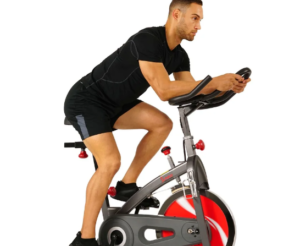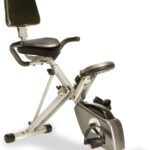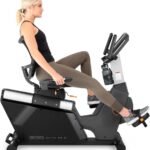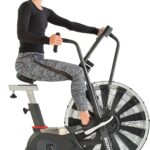Exercise bikes have steadily gained popularity, becoming a preferred workout machine for many fitness enthusiasts worldwide. The concern at the heart of this trend is one that many of us have: how do exercise bikes impact our joint health, particularly the knees? Knees play an important role in our movement; thus, caring for them is essential.
Cycling, whether done outside or on an exercise bike, is popular since it provides a cardiac workout that is also mild on the joints. Because of its low-impact nature, it is popular for individuals who want to mix heart-pumping action with knee-friendly routines. As we learn more about the connection between exercise bikes and our knees, we must remember the importance of preserving knee health. After all, our knees are important not just for movement but also for our overall health and the quality of our active lifestyles.
Is Exercise Bike Good for Knees?
Yes, exercise bikes can be really useful to the knees. Cycling on an exercise bike, instead of high-impact workouts like jogging, provides a low-impact cardiovascular activity that ensures the knees are subjected to minimal stress. This smooth, circular pedaling motion can help strengthen the muscles surrounding the knee, such as the quadriceps and hamstrings, providing greater joint support. Regular cycling can also increase joint flexibility and blood circulation, promoting overall knee health. Certain types of bikes, such as recumbent bikes, can provide additional support and comfort to those with knee difficulties.
Benefits of Exercise Bikes for Knees
Cycling on an exercise bike can be likened to a gentle breeze – calming yet refreshing, especially for our knees. Here’s why using an exercise bike can be a boon for our knee health:
- Low-Impact Nature: Unlike high-impact activities like running or jumping, cycling provides a smooth motion. This ensures that your knees don’t bear unnecessary stress. This gentle rotation can be especially beneficial for those looking to enjoy a heart-racing workout without stressing their joints.
- Muscle Strengthening: Using an exercise bike regularly can strengthen the surrounding muscles of the knee, namely the quadriceps, and hamstrings. When these muscles are robust, they can better support and protect the knee joint, reducing the risk of injuries.
- Improved Flexibility and Mobility: The pedaling motion promotes flexibility in the knee joints. Over time, this can lead to increased mobility, making everyday tasks like walking or climbing stairs easier and more comfortable.
- Better Blood Circulation: Blood flow is essential for joint health. Cycling ensures that the knee joint and surrounding muscles receive ample blood supply, aiding quicker recovery after workouts and providing essential nutrients to the joint structures.
Exercise bikes are a favorite choice for people looking for a workout that is both excellent for cardiovascular health and gentle on the knees. They serve as a beacon for those who desire to keep their joints healthy while being fit and active. With frequent use and proper technique, one may maximize the various benefits that exercise bikes provide for our knees.
Read: Exercise Bike or Gym Membership
Types of Exercise Bikes and Their Effects on the Knees
Exercise bikes come in various styles and designs, each tailored to fit different fitness needs and preferences. When considering knee health, it’s essential to understand the nuances of each type:
- Upright Bikes: Resembling a regular bicycle, upright bikes position the rider in an upright stance. They offer a balanced workout and can benefit those looking to mimic outdoor cycling indoors. While great for cardiovascular workouts and toning leg muscles, it’s vital to ensure the right seat height to avoid undue stress on the knees.
- Recumbent Bikes: Featuring a laid-back design, they allow users to sit in a reclined position with pedals in front of them. This design provides added support to the lumbar spine, reducing strain on the back. Because of this posture, the knees undergo a different range of motion, making it a suitable choice for those with knee issues or seeking a more relaxed cycling experience.
- Spin Bikes: These bikes are designed for high-intensity workouts, often resembling the feel of road cycling. A heavy flywheel and adjustable resistance allow for a more strenuous workout. Proper technique is crucial here to prevent knee strain. A spin bike can be a rewarding choice for those looking to challenge their fitness levels while keeping knee safety in mind.
Choosing the right type of exercise bike largely depends on personal preferences, fitness goals, and any existing health concerns. Regardless of the choice, paying attention to posture, seat adjustments, and resistance levels can ensure a knee-friendly experience.
Read: Guide to the DP Airgometer Exercise Bike
Tips for Using an Exercise Bike with Existing Knee Problems
Exercise bikes are a fantastic way to stay fit, even for those who have knee concerns. However, if you’ve previously experienced knee problems or are currently dealing with them, it’s essential to approach your cycling sessions with a tad more caution. Here are some guidelines to ensure a safer and more beneficial workout:
- Consult a Professional: Before hopping onto an exercise bike, consider consulting a physiotherapist or a doctor. They can offer personalized advice tailored to your knee condition, ensuring you get the most out of your workouts without aggravating any existing issues.
- Prioritize Warm-Up: A good warm-up can prepare your knee joints and surrounding muscles for the upcoming activity. Gentle stretches and light pedaling for a few minutes can significantly reduce the risk of discomfort or injury during your session.
- Adjust Your Bike Properly: Seat height, pedal position, and handlebar height can all influence how your knees respond during cycling. Ensure all these are adjusted to suit your body’s dimensions. Typically, when the pedal is at its lowest position, there should be a slight bend in your knee.
- Avoid Over-Exertion: Listen to your body. If you feel any discomfort or pain, it might be best to reduce resistance or stop and rest. It’s always better to start with lower resistance and gradually increase as your knees get accustomed to the activity.
- Cool Down is Essential: Just as warming up is crucial, a cool-down phase helps ease any muscle and joint tension. After your main workout, spend a few minutes pedaling at a relaxed pace.
- Consistency Over Intensity: Especially when dealing with knee concerns, it’s more beneficial to maintain a consistent, moderate routine rather than sporadic, high-intensity sessions. This allows your knees to strengthen over time without sudden shocks or stresses.
By following these precautions and advice, you can enjoy the numerous benefits of cycling on an exercise bike while protecting your knees’ health and safety.
Read: How Do Exercise Bikes Calculate Calories
Conclusion
Exercise bikes are a fantastic exercise tool providing cardiovascular benefits and a knee-friendly workout experience. We’ve dived deep into cycling and joint health, from understanding the intricate construction of our knees to comparing various cardio equipment. Regardless of bike or fitness level, focusing on good posture, technique, and individualized guidance can pave the road for optimal knee health. Those with pre-existing knee ailments can still enjoy the benefits of cycling with caution and consistency. So, whether you’re a fitness enthusiast or seeking a mild training solution, exercise bikes can help you achieve your health goals while protecting your knees.




